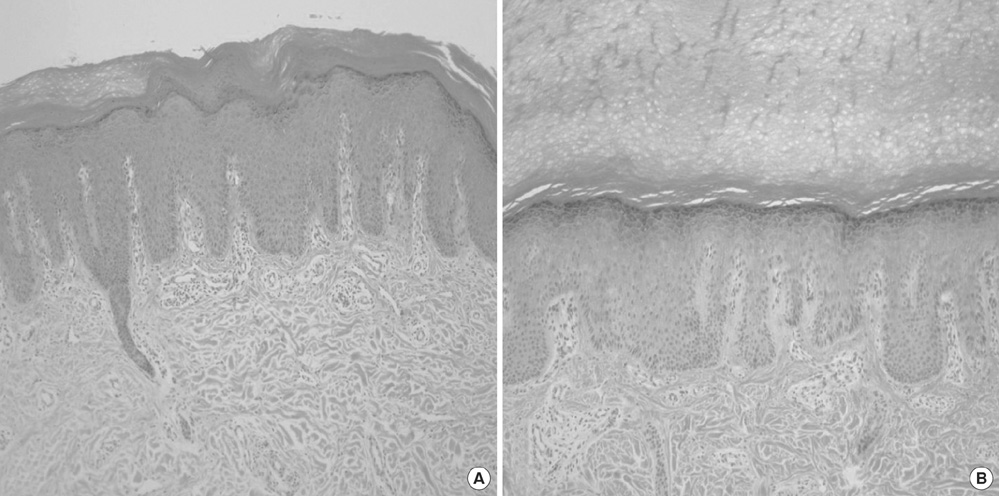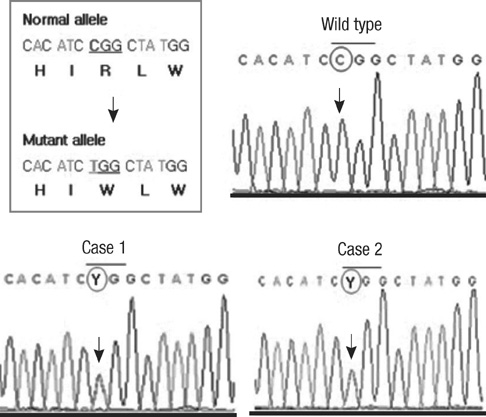J Korean Med Sci.
2010 Oct;25(10):1539-1542. 10.3346/jkms.2010.25.10.1539.
Hereditary Palmoplantar Keratoderma and Deafness Resulting from Genetic Mutation of Connexin 26
- Affiliations
-
- 1Department of Dermatology, Ajou University School of Medicine, Suwon, Korea. maychan@ajou.ac.kr
- 2Department of Genetics, Ajou University School of Medicine, Suwon, Korea.
- 3Department of Otolaryngology, Ajou University School of Medicine, Suwon, Korea.
- KMID: 2157865
- DOI: http://doi.org/10.3346/jkms.2010.25.10.1539
Abstract
- Gap junctions, which mediate rapid intercellular communication, consist of connexins, small transmembrane proteins that belong to a large family of proteins found throughout the species. Mutations in the GJB2 gene, encoding Connexin 26, can cause nonsyndromic autosomal recessive or dominant hearing loss with or without skin manifestations. A 3-yr-old Korean female and her mother presented to our clinic with diffuse hyperkeratosis of the palms and soles (May 3, 2007). Skin biopsies from the soles of both patients demonstrated histopathological evidence of palmoplantar keratoderma. The patient and a number of her maternal family members also had congenital hearing loss. The combination of congenital hearing loss and palmoplantar keratoderma, inherited as an autosomal dominant trait, led us to test for a mutation in the GJB2 gene in both patients. The results showed the R75W mutation of the GJB2 gene in both. In conclusion, the simultaneous occurrence of a GJB2 mutation in a mother and daughter suggests that R75W mutation cause autosomal dominant hearing loss presenting with palmoplantar keratoderma. To the best of our knowledge, this is the first report of a GJB2 mutation associated with syndromic autosomal dominant hearing loss and palmoplantar keratoderma in a Korean family.
Keyword
MeSH Terms
Figure
Reference
-
1. Morton NE. Genetic epidemiology of hearing impairment. Ann N Y Acad Sci. 1991. 630:16–31.
Article2. Kelsell DP, Dunlop J, Stevens HP, Lench NJ, Liang JN, Parry G, Mueller RF, Leigh IM. Connexin 26 mutations in hereditary non-syndromic sensorineural deafness. Nature. 1997. 387:80–83.
Article3. Estivill X, Fortina P, Surrey S, Rabionet R, Melchionda S, D'Agruma L, Mansfield E, Rappaport E, Govea N, Milà M, Zelante L, Gasparini P. Connexin-26 mutations in sporadic and inherited sensorineural deafness. Lancet. 1998. 351:394–398.
Article4. Lee KY, Choi SY, Bae JW, Kim S, Chung KW, Drayna D, Kim UK, Lee SH. Molecular analysis of the GJB2, GJB6 and SLC26A4 genes in Korean deafness patients. Int J Pediatr Otorhinolaryngol. 2008. 72:1301–1309.
Article5. Rouan F, White TW, Brown N, Taylor AM, Lucke TW, Paul DL, Munro CS, Uitto J, Hodgins MB, Richard G. Trans-dominant inhibition of connexin-43 by mutant connexin-26: Implications for dominant connexin disorders affecting epidermal differentiation. J Cell Sci. 2001. 114:2105–2113.
Article6. Heathcote K, Syrris P, Carter ND, Patton MA. A connexin 26 mutation causes a syndrome of sensorineural hearing loss and palmoplantar hyperkeratosis. J Med Genet. 2000. 37:50–51.7. Uyguner O, Tukel T, Baykal C, Eris H, Emiroglu M, Hafiz G, Ghanbari A, Baserer N, Yuksel-Apak M, Wollnik B. The novel R75Qmutation in the GJB2 gene causes autosomal dominant hearing loss and palmoplantar keratoderma in a Turkish family. Clin Genet. 2002. 62:306–309.8. de Zwart-Storm EA, Hamm H, Stoevesandt J, Steijlen PM, Martin PE, van Geel M, van Steensel MA. A novel missense mutation in GJB2 disturbs gap junction protein transport and causes focal palmoplantar keratoderma with deafness. J Med Genet. 2008. 45:161–166.
Article9. Richard G, White TW, Smith LE, Bailey RA, Compton JG, Paul DL, Bale SJ. Functional defects of Cx26 resulting from a heterozygous missense mutation in a family with dominant deaf-mutism and palmoplantar keratoderma. Hum Genet. 1998. 103:393–399.
Article10. Iossa S, Chinetti V, Auletta G, Laria C, De Luca M, Rienzo M, Giannini P, Delfino M, Ciccodicola A, Marciano E, Franzé A. New evidence for the correlation of the p.G130V mutation in the GJB2 gene and syndromic hearing loss with palmoplantar keratoderma. Am J Med Genet A. 2009. 149A:685–688.
Article11. Janecke AR, Nekahm D, Löffler J, Hirst-Stadlmann A, Müller T, Utermann G. De novo mutation of the connexin 26 gene associated with dominant non-syndromic sensorineural hearing loss. Hum Genet. 2001. 108:269–270.
Article12. Yuan Y, Huang D, Yu F, Zhu X, Kang D, Yuan H, Han D, Dai P. A de novo GJB2 (connexin 26) mutation, R75W, in a Chinese pedigree with hearing loss and palmoplantar keratoderma. Am J Med Genet A. 2009. 149A:689–692.
Article13. Park HJ, Hahn SH, Chun YM, Park K, Kim HN. Connexin26 mutations associated with nonsyndromic hearing loss. Laryngoscope. 2000. 110:1535–1538.
Article14. Kelly B, Lozano A, Altenberg G, Makishima T. Connexin 26 mutation in keratitis-ichthyosis-deafness (KID) syndrome in mother and daughter with combined conductive and sensorineural hearing loss. Int J Dermatol. 2008. 47:443–447.
Article15. Evans WH, Martin PE. Gap junctions: structure and function (Review). Mol Membr Biol. 2002. 19:121–136.
Article16. Gonzalez D, Gomez-Hernandez JM, Barrio LC. Molecular basis of voltage dependence of connexin channels: an integrative appraisal. Prog Biophys Mol Biol. 2007. 94:66–106.17. Akiyama M, Sakai K, Arita K, Nomura Y, Ito K, Kodama K, McMillan JR, Kobayashi K, Sawamura D, Shimizu H. A novel GJB2 mutation p.Asn-54His in a patient with palmoplantar keratoderma, sensorineural hearing loss and knuckle pads. J Invest Dermatol. 2007. 127:1540–1543.
Article18. Kelsell DP, Stevens HP. The palmoplantar keratodermas: much more than palms and soles. Mol Med Today. 1999. 5:107–113.
Article
- Full Text Links
- Actions
-
Cited
- CITED
-
- Close
- Share
- Similar articles
-
- A case of Hereditary Epidermolytic Palmoplantar Keratoderma
- A Case of Epidermolytic Palmoplantar Keratoderma
- A case of punctate palmoplantar keratoderma
- Malnutrition-induced Acquired Palmoplantar Keratoderma: A Case Report
- A Case of Hereditary Epidermolytic Palmoplantar Keratoderma in Four Consecutive Generations





